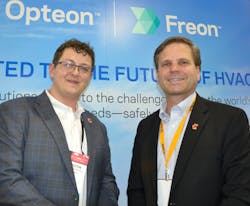Chemours, Johnson Controls Bring Refrigerant Transition Info to Contractors, Distributors
Information sharing is an important element in the HVACR manufacturer/contractor/distributor relationship, and Chemours and Johnson Controls are two companies among those serving as information sources related to the industry’s refrigerant phasedown. It's an ongoing transition that affects all three sectors.
The phasedown of new HFC refrigerants established through the AIM Act and now under the oversight of the Environmental Protection Agency, is underway, starting with a 10 percent reduction of HFC refrigerants that went into effect at the start of 2023. The baseline amount of high global warming potential (GWP) HFC refrigerants produced will be reduced by 40 percent by 2028, 70 percent by 2033, 80 percent by 2035 and 85 percent by 2036. Replacement refrigerants are in the final stage of availability, and include R-454B and R-32 as the two most popular choices.
Joe Martinko, Fluorochemicals Business Director for Chemours, Brandon Marshall, Chemours Regional Marketing Manager, and Chris Forth, Vice President ofRegulatory, Codes & Environmental Affairs for Johnson Controls, were in communication with Contracting Business during and after the 2023 AHR Exposition, about the need for contractors to prepare now for the transition to new refrigerant alternatives.
Chemours's A2L residential HVAC offering is Opteon XL41 (R-454B), now available from Chemours (see bit.ly/opteonready).
"Original equipment manufacturers have done a lot of work to quality A2Ls for new equipment, ahead of what we expect to be January 1, 2025, when the technical standard will be in place requiring them to switch to a low-GWP product. If you're a contractor, the next step is knowing what you need to do to prepare, and make sure that you're trained to use A2Ls, which are different than R-410A,” Martinko said. “The good news is, there's not a lot of difference from a standpoint of the pressures and temperatures and the handling of the material, except for the fact that it’s mildly flammable. Because it’s mildly flammable, there have been many collective efforts in the industry to provide training. At Chemours, we’re doing a number of things. One is webinars, to train contractors or the distribution channel. Secondly, we’re working on NATE-certified training (North American Technician Excellence), going out in-person to put training in place. The third piece is the Chemours website, which has information and videos to help with the transition.
“OEMs are also providing training, as are industry groups like ACCA (Air Conditioning Contractors of America). It has to be a collective effort to get it done, and that is in progress, working to ensure that technicians can handle the product. Once this transition occurs within the OEMs, it will go pretty rapidly because they want to move to the low GWP product,” Martinko continued.
Existing HFC-charged HVAC systems will of course require ongoing service for as long as they are in operation, and for the refrigerant phasedown to be successful and less stress-inducing for servicing contractors, the transition process will require diligent refrigerant reclamation and recovery by contractors, to ensure that they have sufficient amounts of service gas in stock for older systems still charged with R-410A or R-22.
Training, although not at all extensive, will require time, to be certain technicians understand how to implement these products safely.
Martinko said there is a “back to basics” element related to HVAC system integrity, apart from type of refrigerant that is used, which includes, “making sure systems are tight, making sure that [technicians] are not venting product and following standard [service] practices. With the A2L refrigerants, it’s a matter of knowing what tweaking needs to be done, what the standard practice will be. There will be some differences as far as hoses and connections, but not big differences. It’s making sure they can handle the product safely and then have the product ready to go when we start to see the transition.”
Training, although not at all extensive, will require time, to be certain technicians understand how to implement these products safely, although they’re really not very different from the refrigerants we’re using today, Martinko shared. "They are mildly flammable, and there are some considerations and best practices that people need to use. A lot of them are [practices] we expect people are using today. It’s really about reinforcing that they re in use to ensure a nice, safe transition and that people understand how to work with these products moving forward.”
"The Chemours website (chemours.com) provides information and videos to help inform. OEMs are also providing training, as well as groups such as ACCA (Air Conditioning Contractors of America). It needs to be a collective effort to get it done.”
Marshall said contractors’ most frequently asked question is related to the flammability of A2L refrigerants. To help demonstrate the mild flammability aspect of A2Ls, a video was produced to show the difference between R-290 (propane) and R-454C, a “close cousin” to R-454B. In the video, the R-454B refrigerant takes on a blue color but tapers out quickly. Additional testing by The Air-Conditioning, Heating, and Refrigeration Institute (AHRI) in cooperation with Underwriters Laboratories (UL) and the Firefighter Safety Research Institute (FSRI) determined that A2L refrigerants are difficult to ignite, and have low flame spread.
For commercial refrigeration, Chemours is offering two main products, Opteon XP40 (R-449A) and Opteon XP10 (R-513A). “XP 40 is an optimal replacement for R-404 and R-407, as well as R-22, for centralized supermarket applications, walk-in coolers and even some specialty, self-contained applications that are difficult to replace,” Marshall said. “We have a lot of experience with XP40 in those applications. A lot of case studies have been generated over time, and it really allows end users to move away from products like R-404 quickly, especially if they have a reasonable amount of system life left.
“For example, if a company purchased equipment five years ago that's using R-404A today, they have a good amount of life left in them -- 10 to 20 years in some cases. So, looking at the equipment life and how long you expect that piece of equipment to last, we do anticipate and really highly recommend that people retrofit over to products like R-449A, to help reduce that demand for R-404A. R-513 is an interesting one because it is a lower GWP replacement for R-134A as well as other R 22 service blends.
“That product comes in at a GWP of 631. So it's compliant for a lot of the new regulations that we're seeing for air conditioning. It's heavily used in chillers today, but it's quickly found a home in certain industrial applications, especially a medium temp beverage cooling. It’s a great retrofit solution if you're using R-134A and you're looking to keep that system in play for a, a decent amount of time. But we've even seen, uh, that retailers have been retrofitting some of their systems, especially those in California, to have to meet the carb requirements of 1400 GWP or less by 2030 as a great option for them to work those gwp even lower, faster.”
Johnson Controls will be utilizing Opteon XL41 to replace R-410A in all residential and commercial unitary products and air-cooled scroll chillers it manufactures. Forth said JCI will begin manufacturing equipment utilizing Opteon XL41 in early 2024, well ahead of the EPA’s pending January 1, 2025 deadline.
Forth agreed with Martinko and Marshall as to the importance of supporting HVACR contractors throughout the transition to A2L refrigerants.
"Proper training is critical to ensure the safe use, transportation and storage of A2L refrigerants, such as Opteon XL41, and training is also critical fromDuring 2022 and proceeding through the EPA’s January 1, 2025 deadline, Johnson Controls Technical Services and Ducted Systems Training Academy teams have and will continue to develop and share training resources for Johnson Control’s channel partners, which will be made available in a variety of formats including online as well as hands-on, in-person classes. Some of the key topics included are: what’s driving this transition, why these refrigerants are flammable, understanding area building codes, establishing proper refrigerant management practices and creating a reliable supply chain for R-410A reclamation before 2025.
Johnson Controls provides technical training and support materials to its distribution partners through its Ducted Systems Training Academy, which supports hands-on, world class training as well as offering a variety of online options.
“While Johnson Controls always encourages its Original Equipment Manufacturer (OEM) training, we also support industry training from reputable contractor training organizations such as ACCA (Air Conditioning Contractors of America) and ESCO Group, which currently offer A2L training programs. Distributor organizations such as HARDI also provide training resources and support for their members via full-featured Learning Management System as well as discounted pricing,” Forth said.
Similar cooperative efforts throughout the HVAC industry will be critical to a smooth, industry-wide transition away from HFC refrigerants.











